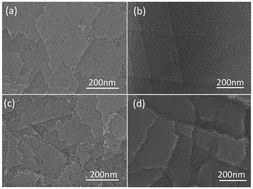Au nanocrystal superlattices: nanocrystallinity, vicinal surfaces, and growth processes†
Abstract
Vicinal Au supracrystal surfaces were prepared from Ausingle single domain nanocrystals (NCs), whereas by replacing Ausingle with their polycrystalline counterparts common low-energy supracrystal surfaces were produced. By analogy to atomic crystalline surfaces, we propose a mechanism to explain the formation of such unexpected supracrystal vicinal surfaces, composed of only Ausingle NCs which are non-compact (bct structure) with a coherent alignment of the atomic planes oriented along the [111] superlattice axis and a slight tilt configuration (8.1°) of NCs. In the presence of Co(ε) NCs, these Ausingle supracrystals lose both the slightly tilted configuration of NCs and their orientational order leading to a superlattice transition from bct to fcc. In contrast, supracrystals of Aupoly NCs are insensitive to the presence of Co(ε) NCs. These intriguing structural changes obtained with Ausingle compared to Aupoly supracrystals in the absence and presence of Co(ε) NCs could explain the formation of vicinal surfaces. Note that the solvent used to disperse the nanocrystals plays a key role in the formation of supracrystal vicinal surfaces. Here, a new analogy between supracrystals and atomic crystals is presented.



 Please wait while we load your content...
Please wait while we load your content...